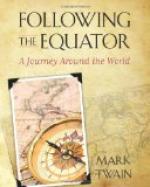When Jameson learned that near Krugersdorp he would find 800 Boers waiting to dispute his passage, he was not in the least disturbed. He was feeling as he had felt two or three days before, when he had opened his campaign with a historic remark to the same purport as the one with which the commander of the 94th had opened the Boer-British war of fourteen years before. That Commander’s remark was, that the Boers “would turn tail at the first beat of the big drum.” Jameson’s was, that with his “raw young fellows” he could kick the (persons) of the Boers “all round the Transvaal.” He was keeping close to historic precedent.
Jameson arrived in the presence of the Boers. They—according to precedent—were not visible. It was a country of ridges, depressions, rocks, ditches, moraines of mining-tailings—not even as favorable for cavalry work as Laing’s Nek had been in the former disastrous days. Jameson shot at the ridges and rocks with his artillery, just as General Colley had done at the Nek; and did them no damage and persuaded no Boer to show himself. Then about a hundred of his men formed up to charge the ridge-according to the 58th’s precedent at the Nek; but as they dashed forward they opened out in a long line, which was a considerable improvement on the 58th’s tactics; when they had gotten to within 200 yards of the ridge the concealed Boers opened out on them and emptied 20 saddles. The unwounded dismounted and fired at the rocks over the backs of their horses; but the return-fire was too hot, and they mounted again, “and galloped back or crawled away into a clump of reeds for cover, where they were shortly afterward taken prisoners as they lay among the reeds. Some thirty prisoners were so taken, and during the night which followed the Boers carried away another thirty killed and wounded—the wounded to Krugersdorp hospital.” Sixty per cent. of the assaulted force disposed of—according to Mr. Garrett’s estimate.
It was according to Amajuba precedent, where the British loss was 226 out of about 400 engaged.
Also, in Jameson’s camp, that night, “there lay about 30 wounded or otherwise disabled” men. Also during the night “some 30 or 40 young fellows got separated from the command and straggled through into Johannesburg.” Altogether a possible 150 men gone, out of his 530. His lads had fought valorously, but had not been able to get near enough to a Boer to kick him around the Transvaal.
At dawn the next morning the column of something short of 400 whites resumed its march. Jameson’s grit was stubbornly good; indeed, it was always that. He still had hopes. There was a long and tedious zigzagging march through broken ground, with constant harassment from the Boers; and at last the column “walked into a sort of trap,” and the Boers “closed in upon it.” “Men and horses dropped on all sides. In the column the feeling grew that unless it could burst through the Boer lines at this point it was done for. The Maxims were fired until they grew too hot, and, water failing for the cool jacket, five of them jammed and went out of action. The 7-pounder was fired until only half an hour’s ammunition was left to fire with. One last rush was made, and failed, and then the Staats Artillery came up on the left flank, and the game was up.”




